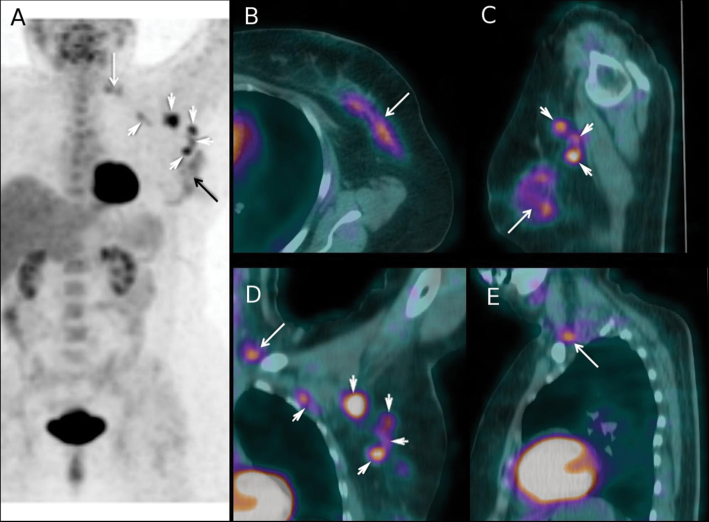Figure 1.
Fluorodeoxyglucose positron emission tomography/computed tomography (18FDG-PET-CT) findings in a 63-year-old woman with a 90-mm invasive mixed ductal/lobular carcinoma of the left breast (tumor phenotype = estrogen receptor positive, human epidermal growth factor receptor 2 negative, grade 2) and matted lymph nodes in axilla level 1. Based on clinical examination and loco-regional workup, the patient was clinically staged IIIA (cT3 cN2a cM0). A) Maximum intensity projection image PET showing 18FDG uptake in the primary tumor (black arrow), in lymph nodes at level 1 and 2 of axilla (white arrowheads), and in supraclavicular lymph nodes (white arrow). B) Axial projection PET-CT fusion images through the left breast showing the primary tumor (white arrow). C) PET-CT sagittal projection showing the primary tumor (white arrow) and three level 1 axillary lymph nodes (white arrowheads). D) PET-CT coronal section showing 18FDG uptake in level 1 and level 2 nodes (white arrowheads) and in a supraclavicular node (white arrow). E) PET-CT sagittal section showing 18FDG uptake in one supraclavicular node (white arrow). After PET-CT, cancer was classified cT3 cN3c cM0 (stage IIIC). The neoadjuvant chemotherapy regimen was performed as planned (4 cycles of epirubicin 75mg/m² plus cyclophosphamide 750mg/m² followed by 4 courses of docetaxel 100mg/m²). After completion of neoadjuvant chemotherapy, the patient underwent mastectomy, axillary lymph node dissection, and, because of data from the initial PET-CT scan, additional dissection of the supraclavicular area. Pathological examination showed residual tumor in breast with >50% pathological response, six axillary metastases (with evidence of therapeutic effect), and tumor-involved supraclavicular nodes (with evidence of therapeutic effect). Radiation therapy to the chest wall and locoregional basins was performed, and the patient received adjuvant hormone therapy. At 24 months of follow-up, no recurrence was observed.

